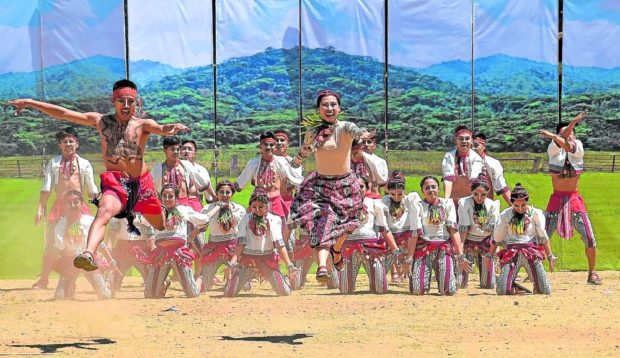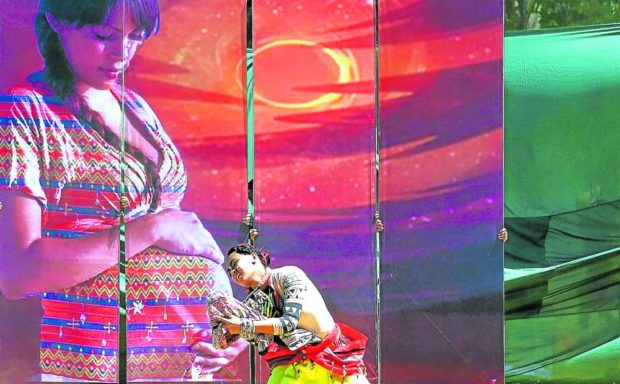IP scholars seek protection of Cordillera rites in festivals

AUTHENTICITY | Before the COVID-19 pandemic struck in 2020, street-dancing troupes in colorful costumes attracted crowds to Panagbenga, or the Baguio Flower Festival. But scholars say these performances blur the line between authentic yet protected traditions and style and choreography that are simply influenced by Cordillera culture. (Photo by EV ESPIRITU / Inquirer Northern Luzon)
BAGUIO CITY, Benguet, Philippines — Performances with lavish costumes during tourism-related events like this city’s crowd-drawing Panagbenga (Baguio Flower Festival) should be properly labeled as “innovations” to distinguish them from authentic and ritual-based cultural traditions that must be protected from commercialization.
That was one of the recommendations offered by Cordillera scholars during a public consultation on the proposed creation of a Baguio Culture and Arts Council last week.
Cordillera dances and unique festival garments are showcased during community festivals to entertain tourists, a feature of a creative economy that generates income for the city but is often criticized as “cultural bastardization.”
Diverse
This is because many people are unable to separate genuine traditional performances from choreography “that was influenced by authentic traditions,” so tourism event organizers must make the extra effort to explain the difference, said professor Jimmy Fong, dean of the College of Arts and Communication at the University of the Philippines Baguio, during the forum on Sept. 8.
Baguio is the “home of culturally diverse ethnolinguistic groups” who have their own distinct community guidelines regarding their traditions that must be respected, so regulations against cultural misappropriation have become necessary, said Lucia Balwayan Ruiz, author and cultural literacy advocate, who led the consultation.
Article continues after this advertisementSome of the city’s more than 360,000 residents come from the Cordillera Administrative Region, which was formed in 1987 by then President Corazon Aquino following peace negotiations with rebel priest Conrado Balweg.
Article continues after this advertisementThe Cordillera is among the regions hosting a large cluster of indigenous peoples (IP) groups. The region is composed of the provinces of Benguet (including Baguio City), Abra, Ifugao, Apayao, Kalinga and Mountain Province.
The proposed culture and arts council was not meant to regulate cultural activities, said the measure’s author, Councilor Vladimir Cayabas.

CULTURAL SHOWCASE | One of the performances during the 2019 staging of the Baguio Flower Festival features glimpses of family values among Cordillerans. (Photo by EV ESPIRITU / Inquirer Northern Luzon)
Awareness
“It aims to level up awareness and appreciation of Cordillera culture and the need for its preservation. It promotes culture and arts literacy — like [showing the average Filipino] the difference between authentic indigenous rituals and exogenous cultural practices,” Cayabas told the Inquirer.
But he said the council might enact a separate ordinance that would respond to cultural offenses.
Some of the consultation’s participants complained about entrepreneurs in the city’s parks, who rent out “Igorot costumes” which tourists wear for their souvenir “selfies.”Ruiz said the term “costume” to describe the “tapis” (wraparound skirt) and “bahag” (G-string) was offensive.
“We don’t wear costumes; this is our attire,” she said.
In fact, these garments were the equivalent of “everyday work clothes” in the past when farmers tended to their mountainside gardens, or when women carried their harvests to the closest community market, said Fong, an Ibaloy from Benguet.
He said some “purists” falsely ascribe ceremonial functions to the native attire, which adds to the blurring of Cordillera-inspired entertainment and genuine cultural expressions.
In promoting true Cordillera culture, Fong urged scholars and the city council to first “question our ideas of what is sacred, authentic and original.”
“We have not really preserved all that is traditional at this point. Do you know the colors of the Benguet cloth, which is now black and red, was originally indigo but we no longer make the traditional indigo dyes?” he said.
RELATED STORIES
Cordillera weavers as visual artists
Mount Data Hotel: Cordillera’s peace hub
‘1941’: In Cordillera, film is a cultural weapon vs distortion